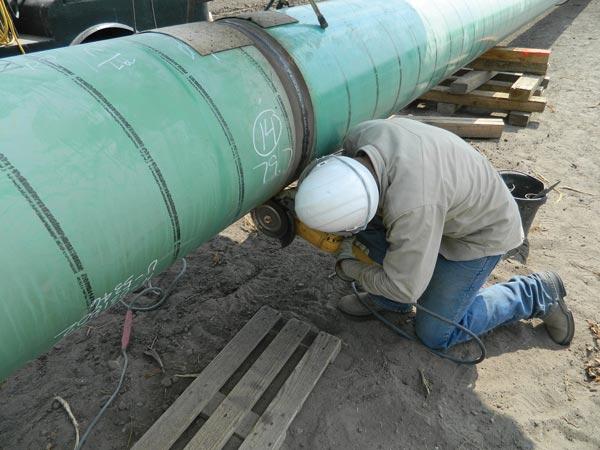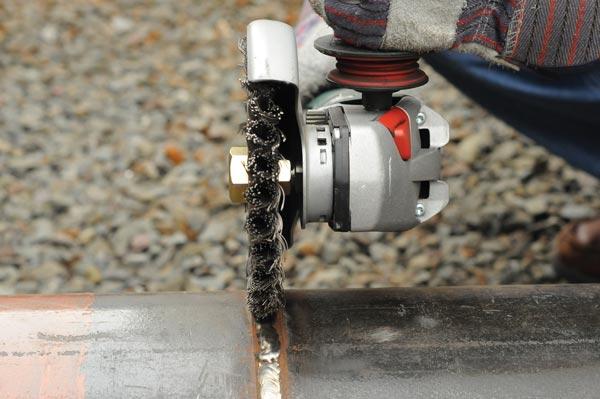- FMA
- The Fabricator
- FABTECH
- Canadian Metalworking
Weld Cleanup Poses Challenges for Oilfield Workers
Flipping weld cleaning brushes frequently improves productivity, safety
- May 23, 2014
- Article
- Fabricating

Field welding applications can present additional challenges in weld cleaning because of the environment and out-of-position work.
Interpass and postweld surface cleaning in field applications, such as pipeline welding in an oil patch, sometimes requires out-of-position work in conditions that are less than ideal. A welding operator may have to lie on his back in the mud, for example, to clean an overhead weld between passes.
Obviously, field applications can present additional challenges in weld cleaning. New technologies that help improve safety and make it easier for operators in the field to properly use power wire brushes also may improve their comfort, productivity, and efficiency.
New brush technology specifically designed for pipeline construction makes flipping the accessory easier to help maximize wire life and safety as the brush wears. The ability to easily switch the mounting position of a weld cleaning brush can contribute to improved safety, productivity, and efficiency in demanding field applications.
Challenges in Field Applications
Industries such as pipeline welding often have stringent code requirements that make surface cleaning to remove the slag and inclusions between each welding pass an important part of completing high-quality welds. Attention to proper weld cleaning is especially critical in field applications, given some of the difficulties that welding outdoors can pose.
An operator often needs to complete the weld cleaning out of position, perhaps lying down or even standing on a ladder. Because almost all pipeline welds must be cleaned, the brushes wear down naturally with use, and some operators have a tendency to push harder as the brush wears.
Applying too much pressure to the brush is a common problem that raises several concerns. With a dull brush, the operator expends more effort and therefore becomes more fatigued, which in turn affects safety and productivity. This is also an issue of wasted worker time for the company.
It can present additional safety concerns when an operator who is working out of position tries to push or force a tool harder than necessary, which creates an even more unfavorable or uncomfortable position for him.
Too much pressure also can damage the wires of the brush more quickly, reducing brush life. It’s important to remember that power brushes are designed to let the wire tips do the work. Operators need to apply only the weight of the tool, without leaning on the brush or pushing hard, for the best and safest results.
Technology Designed for the Field

New technologies help improve safety and make proper use of weld cleaning brushes easier, which enhance productivity and efficiency.
A brush that can be easily flipped or reversed provides numerous advantages for operators and the company. Periodically switching the mounting position of weld cleaning brushes enhances the speed and effectiveness of the brushes, which also improve operator safety.
Because a dull brush is less effective, the operator has to work harder to get results. Being able to flip the brush easily improves the operator’s productivity and thus has an impact on savings and the ROI of the tools.
Some newer weld cleaning brushes are designed with a dual-hex nut to allow for easy flipping of the wheel and elimination of interference issues that pose a safety hazard. The design of these types of brushes features a hex on each side of the wheel and adequate tool clearance, so the wheel position can be changed without removing the guard from the tool.
Because the grinder rotates in one direction, the wire tips become dull in that direction over time. Flipping the brush allows the operator to use the other side of the tips, which become razor-sharp as the opposite sides wear.
Best Use
Operators shouldn’t wait to flip the tool until they notice a brush has become dull or wires start to break. Flipping the brush periodically, before dull wires make it necessary, will help keep the wires sharp and the tool most efficient and productive. If the operator has to apply pressure to get the job done, it’s likely the brush needs to be flipped or replaced.
A dull brush can lead to underbrushing of the weld joint. This problem can lead to inclusions or defects left in the weld, which can adversely affect quality and possibly lead to rework.
Flipping the brush too often is not a concern, so operators can make a habit out of periodically changing the mounting position. Regular inspection still is important, however, to know when a brush has reached the end of its useful life.
Also, because the wire tips of power brushes are designed to do the work, operators should keep in mind the angle at which they are holding the brush in relation to the work surface. The tips should be perpendicular to the weld being cleaned to minimize the amount of flex in the wires and reduce the likelihood of wire breakage.
Running a power wire wheel brush at an angle means the operator is using the sides of the wires rather than the tips. Therefore, the brush isn’t doing as much work and the operator pushes harder, causing wire breakage. Holding the wire wheel brush perpendicular to the weld improves performance, cleaning results, and safety, because the operator doesn’t have to work as hard to get results.
Proper brush storage is especially important in field applications, where weather and harsh conditions may be an issue. Clean, dry storage helps keep wire brushes in safe working condition, free from rust and damage.
Related Companies
subscribe now


Keep up to date with the latest news, events, and technology for all things metal from our pair of monthly magazines written specifically for Canadian manufacturers!
Start Your Free Subscription- Trending Articles
- Industry Events
MME Winnipeg
- April 30, 2024
- Winnipeg, ON Canada
CTMA Economic Uncertainty: Helping You Navigate Windsor Seminar
- April 30, 2024
- Windsor, ON Canada
CTMA Economic Uncertainty: Helping You Navigate Kitchener Seminar
- May 2, 2024
- Kitchener, ON Canada
Automate 2024
- May 6 - 9, 2024
- Chicago, IL
ANCA Open House
- May 7 - 8, 2024
- Wixom, MI














